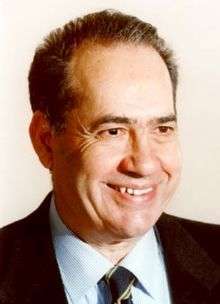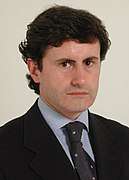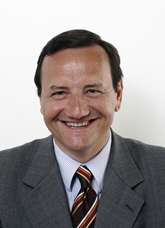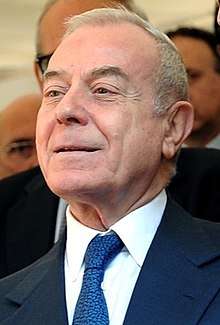Berlusconi III Cabinet
The Berlusconi III Cabinet was the cabinet of the government of Italy from 23 April 2005 to 17 May 2006. It was the 58th cabinet of the Italian Republic, and the second cabinet of the XIV Legislature.
| Berlusconi III Cabinet | |
|---|---|
58th Cabinet of Italy | |
 | |
| Date formed | 23 April 2005 |
| Date dissolved | 2 May 2006 (375 days) |
| People and organisations | |
| Head of state | Carlo Azeglio Ciampi |
| Head of government | Silvio Berlusconi |
| No. of ministers | 25 (incl. Prime Minister) |
| Total no. of members | 26 (incl. Prime Minister) |
| Member parties | FI, AN, UDC, LN, NPSI, PRI |
| Status in legislature | Centre-right coalition |
| Opposition parties | DS, DL, PRC, UDEUR, SDI, FdV, PdCI |
| History | |
| Outgoing election | 2006 election |
| Legislature term(s) | XIV Legislature (2001 – 2006) |
| Incoming formation | Berlusconi III Cabinet formation, 2005 |
| Predecessor | Berlusconi II Cabinet |
| Successor | Prodi II Cabinet |
Formation
House of Freedoms did not do as well in the 2003 local elections as it did in the 2001 national elections. In common with many other European governing groups, in the 2004 elections of the European Parliament, gaining 43.37% support. Forza Italia's support was also reduced from 29.5% to 21.0% (in the 1999 European elections Forza Italia had 25.2%). As an outcome of these results the other coalition parties, whose electoral results were more satisfactory, asked Berlusconi and Forza Italia for greater influence in the government's political line.
In the 2005 regional elections (3-4 April 2005), the centre-left gubernatorial candidates won in 12 out of 14 regions where control of local governments and governorships was at stake. Berlusconi's coalition kept only two of the regional bodies (Lombardy and Veneto) up for re-election. Three parties, Union of Christian and Centre Democrats, National Alliance and New Italian Socialist Party, threatened to withdraw from the Berlusconi government. The Italian Premier, after some hesitation, then presented to the President of the Republic a request for the dissolution of his government on 20 April 2005. On 23 April he formed a new government with the same allies, reshuffling ministers and amending the government programme. A key point required by the Union of Christian and Centre Democrats (and to a lesser extent by National Alliance) for their continued support was that the strong focus on tax reduction central to the government's ambitions be changed.
New electoral law
During this second cabinet was also approved a new electoral law. A white paper for a proportional-only electoral system was presented to the Chamber of Deputies on September 13, 2005, only seven months before the 2006 general election. This reform, strongly backed by the Union of Christian and Centre Democrats, proposed a 4% election threshold before a party gained any seats, and a majority bonus of (at least) 340 seats for the winning coalition, the total votes for each coalition being the sum of the votes of those coalition parties which had won at least 4% of the national votes. The new proposal was approved by parliament.[1]
An electoral survey published on September 15, 2005 by the national left newspaper La Repubblica[2] claimed that, with the initial proposal of electoral reform become law, the House of Freedoms would win the next elections 340-290, even if they won only 45% of votes and the opposition coalition The Union won 50%, because the Union also includes several small parties with less than 4% of national votes. This could have been avoided if the small opposition parties ran on a common ticket. Aim of this bill of reform was to reduce the number of parties, and particularly the moderate Left would have taken advantage in respect to the smaller radical left parties.
The Union of Christian and Centre Democrats, commenting on the proposal, asked for the abolition of the 4% cut-off clause, whereas the National Alliance did not show any favour to this attempt of reform, with its leader Gianfranco Fini claiming to want first to vote for the constitutional reform, and then for the new voting system, on condition that the 4% cut-off were not repealed.[3]
This proposal of law was strongly questioned by the opposition coalition, who defined it an "attempted coup". Opposition leader Romano Prodi said it was "totally unacceptable".[4] Several newspapers politically oriented to the left nicknamed the electoral system proposal by the House of Freedoms as "Truffarellum", after "truffa" (Italian for "fraud") and the "Mattarellum", (from Sergio Mattarella), the most common name for the previous Italian electoral law (there is a recent custom to nickname new electoral systems by a somewhat Latinised version of the name of the lawmaker; another one is the system used in regional elections, the so-called "Tatarellum" from Pinuccio Tatarella).
Notably, some smaller opposition parties, such as Communist Refoundation Party and UDEUR, support a proportional electoral law; nevertheless, they declared they were against an electoral reform by this parliament, because the current law would be changed too close to the 2006 general election.
The Italian prime minister Silvio Berlusconi had previously been a strong supporter of the plurality-based electoral law; in 1995, talking about his coalition, he even defined the plurality principle as "our religion".[5]
A modified version of the first proposal, this time with a 2% threshold for entering Parliament and without vote of preference for candidates, but still without the support of the opposition, was presented to the Chamber of Deputies. The voting count started on October 11; the lower house of Italian parliament then approved the electoral reform on October 14.[6] The new electoral was then eventually approved on December 16, 2005, and countersigned by President Ciampi on December 23, 2005.[7]
Roberto Calderoli, the main author of this electoral reform, defined this law "a rascality" (using the mildly vulgar term "porcata").
Ironically, the new electoral law allowed Romano Prodi to count on a large majority in the Chamber and to obtain majority also in the Senate, where The House of Freedoms actually had more votes (49.88% vs. 49.18% of the Union).
Party breakdown
Beginning of term
Ministers
11 | |
5 | |
3 | |
|
3 |
1 | |
1 |
Ministers and other members
- Forza Italia (FI): Prime minister, 1 Deputy Prime minister, 10 ministers, 35 undersecretaries
- National Alliance (AN): 6 ministers (incl. 1 Deputy Prime minister), 16 undersecretaries
- Union of Christian and Centre Democrats (UDC): 3 ministers, 9 undersecretaries
- Northern League (LN): 3 ministers, 9 undersecretaries
- New Italian Socialist Party (NPSI): 1 minister, 2 undersecretaries
- Italian Republican Party (PRI): 1 minister, 1 undersecretary
- Independents: 1 minister, 1 undersecretary
End of term
Ministers
10 | |
6 | |
3 | |
|
3 |
1 | |
1 | |
1 |
Ministers and other members
- Forza Italia (FI): Prime minister, 9 ministers, 3 deputy ministers, 32 undersecretaries
- National Alliance (AN): 5 ministers (incl. 1 Deputy Prime minister), 3 deputy ministers, 12 undersecretaries
- Union of Christian and Centre Democrats (UDC): 3 ministers, 1 deputy minister, 8 undersecretaries
- Northern League (LN): 3 ministers, 9 undersecretaries
- New Italian Socialist Party (NPSI): 1 minister, 1 deputy minister, 1 undersecretary
- Italian Republican Party (PRI): 1 minister, 1 deputy minister
- Independents: 1 undersecretary
Composition of the Government
| Portrait | Office | Name | Term | Party | Deputy Ministers Undersecretaries | |
|---|---|---|---|---|---|---|
 |
Undersecretaries: Gianni Letta (Ind.) Paolo Bonaiuti (FI) | |||||
 |
||||||
.jpg) |
||||||
.jpg) |
Undersecretaries: Roberto Antonione (FI) Giampaolo Bettamio (FI) Margherita Boniver (FI) Giuseppe Drago (UDC) Alfredo Mantica (AN) | |||||
 |
Undersecretaries: Maurizio Balocchi (LN) Antonio D'Alì (FI) Gianpiero D'Alia (UDC) Alfredo Mantovano (AN) Michele Saponara (FI) | |||||
.jpg) |
Undersecretaries: Pasquale Giuliano (FI) Jole Santelli (FI) Giuseppe Valentino (AN) Luigi Vitali (FI) | |||||
 |
Deputy Ministers: Mario Baldassarri (AN)[lower-alpha 1] (since 1 July 2005) Giuseppe Vegas (FI)[lower-alpha 1] (since 1 July 2005) Undersecretaries: Maria Teresa Armosino (FI) Manlio Contento (AN) Daniele Molgora (LN) Michele Vietti (UDC) | |||||
 |
||||||
 |
(ad interim) |
|||||
 |
Deputy Ministers: Adolfo Urso (AN)[lower-alpha 2] (since 23 May 2005) Undersecretaries: Giovambattista Caligiuri (FI) Roberto Cota (LN) Giuseppe Galati (UDC) Mario Valducci (FI) | |||||
.jpg) |
Deputy Ministers: Guido Possa (FI)[lower-alpha 2] (since 23 May 2005) Giovanni Ricevuto (NPSI)[lower-alpha 2] Undersecretaries: Valentina Aprea (FI) Maria Grazia Siliquini (AN) | |||||
 |
Undersecretaries: Alberto Brambilla (LN) Saverio Romano (UDC) Roberto Rosso (FI) Maurizio Sacconi (FI) Grazia Sestini (FI) Pasquale Viespoli (AN) | |||||
 |
Undersecretaries: Filippo Berselli (AN) Francesco Bosi (UDC) Salvatore Cicu (FI) Rosario Giorgio Costa (FI) | |||||
 |
Undersecretaries: Teresio Delfino (UDC) Gianpaolo Dozzo (LN) Paolo Scarpa (FI) | |||||
 |
Deputy Ministers: Francesco Nucara (PRI)[lower-alpha 2] (since 23 May 2005) Undersecretaries: Stefano Stefani (LN) Roberto Tortoli (FI) | |||||
 |
Deputy Ministers: Ugo Martinat (AN)[lower-alpha 2] (since 23 May 2005) Mario Tassone (UDC)[lower-alpha 2] (since 23 May 2005) Undersecretaries: Federico Bricolo (LN) Mauro Del Bue (NPSI) Silvano Moffa (AN) Paolo Uggè (FI) Guido Viceconte (FI) Nino Sospiri (AN) (until 2 January 2006) | |||||
.jpg) |
Undersecretaries: Elisabetta Casellati (FI) Cesare Cursi (AN) Domenico Di Virgilio (FI) Domenico Zinzi (UDC) | |||||
 |
(ad interim) |
|||||
 |
Deputy Ministers: Antonio Martusciello (FI)[lower-alpha 3] (since 18 July 2005) Undersecretaries: Nicola Bono (AN) Mario Pescante (FI) | |||||
 |
Undersecretaries: Massimo Baldini (FI) Paolo Romani (FI) | |||||
 |
(without portfolio) |
Undersecretaries: Alberto Gagliardi (FI) Luciano Gasperini (LN) | ||||
 |
(without portfolio) |
Undersecretaries: Giovanni Dell'Elce (FI) | ||||
 |
(without portfolio) |
Undersecretaries: Learco Saporito (AN) | ||||
 |
(without portfolio) |
|||||
.jpg) |
(without portfolio) |
|||||
.jpg) |
(without portfolio) |
|||||
 |
(without portfolio) |
|||||
 |
(without portfolio) |
Undersecretaries: Aldo Brancher (FI) Nuccio Carrara (AN) | ||||
 |
(without portfolio) |
Undersecretaries: Cosimo Ventucci (FI) Gianfranco Conte (FI) | ||||
 |
(without portfolio) |
|||||
 |
— | |||||
- Undersecretary until 1 July 2005
- Undersecretary until 23 May 2005
- Undersecretary until 18 July 2005
Sources
References
- Pole Agrees to Go Back to Proportional Vote, Corriere della Sera
- (in Italian) Dalla vittoria alla sconfitta la riforma "scippa" l'Unione, La Repubblica
- , Reuters
- (in Italian) Legge elettorale, accordo nella Cdl Unione insorge: "Blocchiamo le Camere", La Repubblica
- (in Italian) Nessun blitz prima delle elezioni Archived 2011-07-23 at the Wayback Machine, DS Milano
- Italy deputies back voting reform, BBC News
- (in Italian) Ciampi ha firmato la legge elettorale, Corriere della Sera
